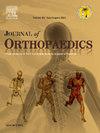反门:全膝关节置换术中骨质量的术前x线评估与骨矿物质密度相关
IF 1.5
Q3 ORTHOPEDICS
引用次数: 0
摘要
背景:在全国范围内,无骨水泥全膝关节置换术(TKA)的数量有所增加。虽然存在膝关节的放射学分类系统,但这些算法尚未与骨矿物质密度(BMD)相关。我们的目的是将膝关节的x线测量与术前骨密度相关联,并建立一个预测骨质减少的模型。材料和方法我们前瞻性地招募了100例患者,计划进行选择性TKA,术前进行双能x线吸收仪(DEXA)扫描。四位独立的外科医生在术前x线片上测量了膝关节皮质指数,并将这些比率与局部骨密度相关联。类内相关性(ICC)用于评估观察者间的可靠性,Pearson相关系数(PCC)用于描述骨密度与x线摄影比值之间关系的强度。建立“反向Dorr”模型评价股骨远端皮质指数的比值。采用Logistic回归预测骨质减少的几率。结果我们发现几个膝关节皮质比值与骨密度相关,但侧位片相关性最高。所有的测量结果显示,至少,公平的观察者间信度,大多数达到ICC >;0.81。股骨近端与股骨远端比值,“反向Dorr”模型,被发现是骨质减少的一个强有力的预测因子,ROC为0.7335。结论:该x线片评估表明,膝关节皮质厚度与骨密度相关,尤其是侧位片。使用“反向Dorr”模型可以预测骨质减少,并有助于指导种植体的选择。本文章由计算机程序翻译,如有差异,请以英文原文为准。
The Reverse Dorr: Preoperative radiographic evaluation of bone quality correlates to bone mineral density in total knee arthroplasty
Background
There has been an increase in cementless total knee arthroplasty (TKA) across the country. Although radiographic classification systems of the knee exist, these algorithms have not been correlated to bone mineral density (BMD). We aimed to correlate radiographic measurements of the knee with preoperative BMD and develop a model predictive of osteopenia.
Materials and methods
We prospectively enrolled 100 patients, scheduled to undergo elective TKA, to obtain a preoperative dual energy x-ray absorptiometry (DEXA) scan. Four independent surgeons measured cortical indices of the knee on preoperative radiographs and correlated these ratios with local BMD. Intraclass correlations (ICC) were used to assess interobserver reliability and Pearson correlation coefficients (PCC) to describe the strength of relationship between BMD and radiographic ratios. A “Reverse Dorr” model was created to evaluate the ratio of the distal femur cortical indices. Logistic regression was used to predict the odds of having osteopenia.
Results
We found several cortical ratios of the knee correlated with bone mineral density, but the lateral radiograph had the highest correlation. All measurements showed, at a minimum, fair interobserver reliability with most achieving an ICC >0.81. The proximal femur, distal femur ratio, “Reverse Dorr” model, was found to be a strong predictor of osteopenia with an ROC of 0.7335.
Conclusions
This radiographic assessment demonstrates that cortical thickness of the knee is correlated with bone mineral density—most notably on the lateral radiograph. Utilization of the “Reverse Dorr” model was strongly predictive of osteopenia and may help guide implant selection.
求助全文
通过发布文献求助,成功后即可免费获取论文全文。
去求助
来源期刊

Journal of orthopaedics
ORTHOPEDICS-
CiteScore
3.50
自引率
6.70%
发文量
202
审稿时长
56 days
期刊介绍:
Journal of Orthopaedics aims to be a leading journal in orthopaedics and contribute towards the improvement of quality of orthopedic health care. The journal publishes original research work and review articles related to different aspects of orthopaedics including Arthroplasty, Arthroscopy, Sports Medicine, Trauma, Spine and Spinal deformities, Pediatric orthopaedics, limb reconstruction procedures, hand surgery, and orthopaedic oncology. It also publishes articles on continuing education, health-related information, case reports and letters to the editor. It is requested to note that the journal has an international readership and all submissions should be aimed at specifying something about the setting in which the work was conducted. Authors must also provide any specific reasons for the research and also provide an elaborate description of the results.
 求助内容:
求助内容: 应助结果提醒方式:
应助结果提醒方式:


